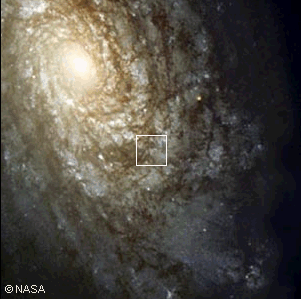Scale: 1021 meters = 1 Zm = 1 zettameter
The Milky WayWe can now see some of the detail of the Milky Way spiral. Our galaxy contains about 1011 stars mutually bound by gravity orbiting in a clockwise direction as seen from above the north galactic pole. The radius of the Milky Way is about 50 000 light years and the Sun orbits the center at a distance of about 30 000 light years. The Sun will complete an orbit of the galaxy once every 250 to 300 million years. Given an estimated age for our solar system of 4.5 thousand million years, the Sun has made about 15 to 18 orbits around the galactic core. The reasons for the spiral structure of many galaxies are still being debated. The spiral arms appear to be the result of density waves of star formation. The fact that about a third of all galaxies are spirals would indicate that the spiral structure of galaxies is stable over long periods of time. (If they were short-lived structures there would be fewer of them at any given time). On the other hand, since the outer stars rotate much more slowly than the inner stars, the arms seemingly should tend to wind up tightly and the spiral structure eventually disappear. The forces that maintain a stable spiral over thousands of millions of years are unclear. Copyright © 2016 by Bruce Bryson |
